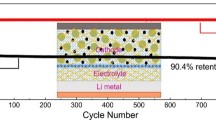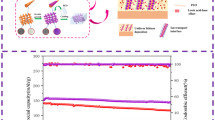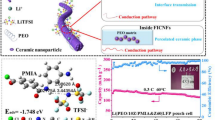Abstract
Quasi-solid-state electrolytes that possess high ionic conductivity, excellent interface stability, and low interfacial resistance, are required for practical solid-state batteries. Herein, a heterogeneous quasi-solid-state hybrid electrolyte (QSHE) with a robust lithium-ion transport layer composed of Li1+xAlxTi2−x(PO4)3 (LATP) nanoparticles (NPs) at the anode/electrolyte interface was fabricated using electrospun nanofibers as a skeleton via a facile in situ polymerization approach. The QSHE exhibits a high ionic conductivity (0.98 mS cm−1), a wide electrochemical window (4.76 V vs. Li/Li+), and favorable compatibility with lithium metal (maintaining stability over 2000 h in a symmetrical cell) at room temperature. When coupled with a Li|LiFePO4 battery, the QSHE enables the battery to retain 95.4% of its capacity after 300 cycles at 2 C. Moreover, the atomic force microscopy verifies the high Young’s modulus of the LATP-dominated bottom layer, while numerical simulation validates the effective distribution of lithium ions at the interface facilitated by LATP NPs, hence contributing to dendrite-free lithium plating/stripping morphology. This straightforward strategy could pave the way for the development of high-performance and interfacially stable lithium metal batteries.
Graphical Abstract







Similar content being viewed by others
Data Availability
All data are available upon reasonable request.
References
Chen Y, Xu M, Huang Y, Manthiram A. Creating a rechargeable world. Chemistry. 2022;8:312.
Ma L, Chen H, Wu J, Lv Y, Chen X, Li X, Li QJ, Di J, Chen Y. Recent progress on zeolitic imidazolate frameworks and their derivatives in alkali metal-chalcogen batteries. Adv Energy Mater. 2021;12:2103152.
Li C, Tong L, Wang S, Liu Q, Wang Y, Li X, Wang M, Li M, Chen X, Wu J, Chen Q, Mai YW, Fan W, Chen Y, Li X. Nitrogen doping induced by intrinsic defects of recycled polyethylene terephthalate-derived carbon nanotubes. SusMat. 2023;3:431.
Iqbal H, Sarwar S, Kirli D, Shek JKH, Kiprakis AE. A survey of second-life batteries based on techno-economic perspective and applications-based analysis. Carbon Neutrality. 2023;2:8.
Ma L, Lv Y, Wu J, Chen Y, Jin Z. recent advances in emerging non-lithium metal-sulfur batteries: a review. Adv Energy Mater. 2021;11:2100770.
Wang Z, Li X, Chen Y, Pei K, Mai Y-W, Zhang S, Li J. Creep-enabled 3D solid-state lithium-metal battery. Chemistry. 2020;6:2878.
Wu J, He J, Wang M, Li M, Zhao J, Li Z, Chen H, Li X, Li C, Chen X, Li X, Mai YW, Chen Y. Electrospun carbon-based nanomaterials for next-generation potassium batteries. Chem Commun. 2023;59:2381.
Li M, Chen H, Wang Y, Chen X, Wu J, Su J, Wang M, Li X, Li C, Ma L, Li X, Chen Y. Two birds with one stone: engineering siloxane-based electrolytes for high-performance lithium-sulfur polyacrylonitrile batteries. J Mater Chem A. 2023;11:11721.
Li C, Qiu M, Li R, Li X, Wang M, He J, Lin G, Xiao L, Qian Q, Chen Q, Wu J, Li X, Mai Y-W, Chen Y. Electrospinning engineering enables high-performance sodium-ion batteries. Adv Fiber Mater. 2022;4:43.
Xu X, Cheng X, Jiang F, Yang S, Ren D, Shi P, Hsu H, Yuan H, Huang J, Ouyang M, Zhang Q. Dendrite-accelerated thermal runaway mechanisms of lithium metal pouch batteries. SusMat. 2022;2:435.
Chen Y, Wang Z, Li X, Yao X, Wang C, Li Y, Xue W, Yu D, Kim SY, Yang F, Kushima A, Zhang G, Huang H, Wu N, Mai YW, Goodenough JB, Li J. Li metal deposition and stripping in a solid-state battery via Coble creep. Nature. 2020;578:251.
Wang M, Wu Y, Qiu M, Li X, Li C, Li R, He J, Lin G, Qian Q, Wen Z, Li X, Wang Z, Chen Q, Chen Q, Lee J, Mai YW, Chen Y. Research progress in electrospinning engineering for all-solid-state electrolytes of lithium metal batteries. J Energy Chem. 2021;61:253.
Li X, Chen W, Qian Q, Huang H, Chen Y, Wang Z, Chen Q, Yang J, Li J, Mai YW. Electrospinning-based strategies for battery materials. Adv Energy Mater. 2020;11:2000845.
Yan C-L. Realizing high performance of solid-state lithium metal batteries by flexible ceramic/polymer hybrid solid electrolyte. Rare Met. 2020;39:458.
Yu Q, Jiang K, Yu C, Chen X, Zhang C, Yao Y, Jiang B, Long H. Recent progress of composite solid polymer electrolytes for all-solid-state lithium metal batteries. Chin Chem Lett. 2021;32:2659.
Wu J, Chen X, Fan W, Li X, Mai Y-W, Chen Y. Rationally designed alloy phases for highly reversible alkali metal batteries. Energy Stor Mater. 2022;48:223.
Zhang H, Chen Y, Li C, Armand M. Electrolyte and anode-electrolyte interphase in solid-state lithium metal polymer batteries: a perspective. SusMat. 2021;1:24.
Yan C, Zhu P, Jia H, Zhu J, Selvan RK, Li Y, Dong X, Du Z, Angunawela I, Wu N, Dirican M, Zhang X. High-performance 3D fiber network composite electrolyte enabled with Li-ion conducting nanofibers and amorphous PEO-based cross-linked polymer for ambient all-solid-state lithium-metal batteries. Adv Fiber Mater. 2019;1:46.
Liu Q, Han X, Wei G, Zhang H, Li Y, Li J, He X. Inorganic composites improving conductivities of solid polymer electrolytes for lithium batteries: a review. ChemNanoMat. 2023;9: e202300202.
Wei C, Liu X, Yu C, Chen S, Chen S, Cheng S, Xie J. Revealing performance of 78Li2S-22P2S5 glass-ceramic based solid-state batteries at different operating temperatures. Chin Chem Lett. 2023;34: 107859.
Wang G, Liang Y, Liu H, Wang C, Li D, Fan L-Z. Scalable, thin asymmetric composite solid electrolyte for high-performance all-solid-state lithium metal batteries. Interdiscip Mater. 2022;1:434.
Zhu J, He S, Tian H, Hu Y, Xin C, Xie X, Zhang L, Gao J, Hao S, Zhou W, Zhang L. The influences of DMF content in composite polymer electrolytes on Li+-conductivity and interfacial stability with Li-metal. Adv Funct Mater. 2023;33:2301165.
Wang L, Shi H, Xie Y, Wu Z-S. Fluorinated boron nitride nanosheet enhanced ultrathin and conductive polymer electrolyte for high-rate solid-state lithium metal batteries. Interdiscip Mater. 2023;2:789.
Yan W, Gao X, Jin X, Liang S, Xiong X, Liu Z, Wang Z, Chen Y, Fu L, Zhang Y, Zhu Y, Wu Y. Nonporous gel electrolytes enable long cycling at high current density for lithium-metal anodes. ACS Appl Mater Interfaces. 2021;13:14258.
Zhijie B, Xiangxin G. Solidification for solid-state lithium batteries with high energy density and long cycle life. Energy Mater. 2022;2: 200011.
Xie X, Wang Z, He S, Chen K, Huang Q, Zhang P, Hao SM, Wang J, Zhou W. Influencing factors on li-ion conductivity and interfacial stability of solid polymer electrolytes, exampled by polycarbonates, polyoxalates, and polymalonates. Angew Chem Int Ed. 2023;135: e202218229.
Matteo P, Akiko T, Henry A, Maria Assunta N, Stefano P. Ionic liquids and their derivatives for lithium batteries: role, design strategy, and perspectives. Energy Mater. 2023;3: 300049.
Wang S, Zhang J, Hua W, Wen L, Tang G, Wang X, Ma C, Chen W. Solvation-enhanced electrolyte on layered oxide cathode tailoring even and stable CEI for durable sodium storage. Carbon Neutrality. 2023;2:20.
Cheng H, Yan C, Orenstein R, Dirican M, Wei S, Subjalearndee N, Zhang X. Polyacrylonitrile nanofiber-reinforced flexible single-ion conducting polymer electrolyte for high-performance, room-temperature all-solid-state Li-metal batteries. Adv Fiber Mater. 2022;4:532.
Wang L, Xu S, Wang Z, Yang E, Jiang W, Zhang S, Jian X, Hu F. A nanofiber–gel composite electrolyte with high Li+ transference number for application in quasi-solid batteries. eScience. 2023;3: 100090.
Yang Y, Yang W, Yang H, Zhou H. Electrolyte design principles for low-temperature lithium-ion batteries. eScience. 2023;3: 100170.
Yu J, Lin X, Liu J, Yu JTT, Robson MJ, Zhou G, Law HM, Wang H, Tang BZ, Ciucci F. In situ fabricated quasi-solid polymer electrolyte for high-energy-density lithium metal battery capable of subzero operation. Adv Energy Mater. 2021;12:2102932.
Chen D, Zhu M, Kang P, Zhu T, Yuan H, Lan J, Yang X, Sui G. Self-enhancing gel polymer electrolyte by in situ construction for enabling safe lithium metal battery. Adv Sci. 2022;9: e2103663.
Liu F, Li T, Yang Y, Yan J, Li N, Xue J, Huo H, Zhou J, Li L. Investigation on the copolymer electrolyte of poly(1,3-dioxolane-co-formaldehyde). Macromol Rapid Commun. 2020;41:2000047.
Liu Q, Cai B, Li S, Yu Q, Lv F, Kang F, Wang Q, Li B. Long-cycling and safe lithium metal batteries enabled by the synergetic strategy of ex-situ anodic pretreatment and an in-built gel polymer electrolyte. J Mater Chem A. 2020;8:7197.
Liu F, Wang W, Yin Y, Zhang S, Shi J, Wang L, Zhang X, Zheng Y, Zhou J, Li L, Guo Y. Upgrading traditional liquid electrolyte via in situ gelation for future lithium metal batteries. Sci Adv. 2018;4:eaat5383.
Li L, Li R, Huang Z, Liu M, Xiang J, Shen X, Jing M. High-performance gel electrolyte for enhanced interface compatibility and lithium metal stability in high-voltage lithium battery. Colloid Surface A. 2022;651: 129665.
Ma Q, Yue J, Fan M, Tan S, Zhang J, Wang W, Liu Y, Tian Y, Xu Q, Yin Y, You Y, Luo A, Xin S, Wu X, Guo Y. Formulating the electrolyte towards high-energy and safe rechargeable lithium-metal batteries. Angew Chem Int Ed. 2021;60:16554.
Huang K, Bi S, Xu H, Wu L, Fang C, Zhang X. Optimizing Li-ion solvation in gel polymer electrolytes to stabilize Li-metal anode. Chemsuschem. 2023;16(19): e202300671.
Rath PC, Liu M, Lo S, Dhaka RS, Bresser D, Yang C, Lee S, Chang JK. Suppression of dehydrofluorination reactions of a Li0.33La0.557TiO3-nanofiber-dispersed poly(vinylidene fluoride-co-hexafluoropropylene) electrolyte for quasi-solid-state lithium-metal batteries by a fluorine-rich succinonitrile interlayer. ACS Appl Mater Interfaces. 2023;15:15429.
Chen H, Li M, Li C, Li X, Wu Y, Chen X, Wu J, Li X, Chen Y. Electrospun carbon nanofibers for lithium metal anodes: progress and perspectives. Chin Chem Lett. 2022;33:141.
Li X, Chen Y, Huang H, Mai YW, Zhou L. Electrospun carbon-based nanostructured electrodes for advanced energy storage—a review. Energy Storage Mater. 2016;5:58.
Chen Z, Kim GT, Kim JK, Zarrabeitia M, Kuenzel M, Liang H, Geiger D, Kaiser U, Passerini S. Highly stable quasi-solid-state lithium metal batteries: reinforced Li1.3Al0.3Ti1.7(PO4)3/Li interface by a protection interlayer. Adv Energy Mater. 2021;11:2101339.
Chen L-H, Huang Z-Y, Chen S-L, Tong R-A, Wang H-L, Shao G, Wang C-A. In situ polymerization of 1,3-dioxolane infiltrating 3D garnet framework with high ionic conductivity and excellent interfacial stability for integrated solid-state Li metal battery. Rare Met. 2022;41:3694.
Xia M, Liu Q, Zhou Z, Tao Y, Li M, Liu K, Wu Z, Wang D. A novel hierarchically structured and highly hydrophilic poly(vinyl alcohol-co-ethylene)/poly(ethylene terephthalate) nanoporous membrane for lithium-ion battery separator. J Power Sources. 2014;266:29.
Li S, Chen Y-M, Liang W, Shao Y, Liu K, Nikolov Z, Zhu Y. A superionic conductive electrochemically stable dual-salt polymer electrolyte. Joule. 1838;2018:2.
Zhao C, Chen P, Zhang R, Chen X, Li B-Q, Zhang X, Cheng X, Zhang Q. An ion redistributor for dendrite-free lithium metal anodes. Sci Adv. 2018;4:eaat3446.
Cui J, Du Y, Zhao L, Li X, Sun Z, Li D, Li H. Thermal stable poly-dioxolane based electrolytes via a robust crosslinked network for dendrite-free solid-state Li-metal batteries. Chem Eng J. 2023;461: 141973.
Zhao Q, Liu X, Stalin S, Khan K, Archer LA. Solid-state polymer electrolytes with in-built fast interfacial transport for secondary lithium batteries. Nat Energy. 2019;4:365.
Liu W, Yi C, Li L, Liu S, Gui Q, Ba D, Li Y, Peng D, Liu J. Designing polymer-in-salt electrolyte and fully infiltrated 3D electrode for integrated solid-state lithium batteries. Angew Chem Int Ed. 2021;60:12931.
Rajendran S, Tang Z, George A, Cannon A, Neumann C, Sawas A, Ryan E, Turchanin A, Arava LMR. Inhibition of lithium dendrite formation in lithium metal batteries via regulated cation transport through ultrathin sub-nanometer porous carbon nanomembranes. Adv Energy Mater. 2021;11:2100666.
Wang Y, Lin C, Rao J, Gaskell K, Rubloff G, Lee SB. Electrochemically controlled solid electrolyte interphase layers enable superior Li–S batteries. ACS Appl Mater Interfaces. 2018;10:24554.
Didwal PN, Singhbabu YN, Verma R, Sung B-J, Lee G-H, Lee J-S, Chang DR, Park C-J. An advanced solid polymer electrolyte composed of poly(propylene carbonate) and mesoporous silica nanoparticles for use in all-solid-state lithium-ion batteries. Energy Storage Mater. 2021;37:476.
Wang H, Wang Q, Cao X, He Y, Wu K, Yang J, Zhou H, Liu W, Sun X. Thiol-branched solid polymer electrolyte featuring high strength, toughness, and lithium ionic conductivity for lithium-metal batteries. Adv Mater. 2020;32:2001259.
Gao Y, Yan Z, Gray JL, He X, Wang D, Chen T, Huang Q, Li YC, Wang H, Kim SH, Mallouk TE, Wang D. Polymer–inorganic solid–electrolyte interphase for stable lithium metal batteries under lean electrolyte conditions. Nat Mater. 2019;18:384.
Acknowledgements
This project was supported by the National Natural Science Foundation of China (No. 22179022, No. 22109023, and No.22209027), the Industry-University Research Joint Innovation Project of Fujian Province (No. 2021H6006), the FuXiaQuan National Independent Innovation Demonstration Zone Collaborative Innovation Platform (No. 2022-P-027), the Youth Innovation Fund of Fujian Province (No. 2021J05043 and No.2022J05046), the Award Program for Fujian Minjiang Scholar Professorship.
Author information
Authors and Affiliations
Corresponding authors
Ethics declarations
Conflict of Interest
YMC is an editorial board member for Advanced Fiber Materials and was not involved in the editorial review or the decision to publish this article. All authors declare that there are no competing interests.
Additional information
Publisher's Note
Springer Nature remains neutral with regard to jurisdictional claims in published maps and institutional affiliations.
Supplementary Information
Below is the link to the electronic supplementary material.
Rights and permissions
Springer Nature or its licensor (e.g. a society or other partner) holds exclusive rights to this article under a publishing agreement with the author(s) or other rightsholder(s); author self-archiving of the accepted manuscript version of this article is solely governed by the terms of such publishing agreement and applicable law.
About this article
Cite this article
Wang, M., Lv, S., Li, M. et al. A Heterogeneous Quasi-solid-State Hybrid Electrolyte Constructed from Electrospun Nanofibers Enables Robust Electrode/Electrolyte Interfaces for Stable Lithium Metal Batteries. Adv. Fiber Mater. 6, 727–738 (2024). https://doi.org/10.1007/s42765-023-00371-8
Received:
Accepted:
Published:
Issue Date:
DOI: https://doi.org/10.1007/s42765-023-00371-8




